Detailed Object and Data Modelling of ATM System Design
VerifiedAdded on 2023/06/14
|15
|2870
|236
Report
AI Summary
This report provides a detailed object and data modeling approach for an ATM system, covering functional and non-functional requirements, use case diagrams, and UML class diagrams. It identifies key functional requirements such as system initialization, card acceptance, PIN request, and transaction processing, as well as non-functional requirements like scalability, flexibility, security, and usability. The report includes use case models for different subsystems, including ATM technician functions and user interactions. A fully developed use case for user transactions is presented, outlining preconditions, success conditions, and main paths. The document also discusses the Software Development Life Cycle (SDLC) phases, including requirement gathering, design, implementation, testing, deployment, and maintenance, with specific tasks for each design activity such as describing the environment, designing application components, user interfaces, and the database. This assignment is available on Desklib, a platform offering study tools and resources for students.
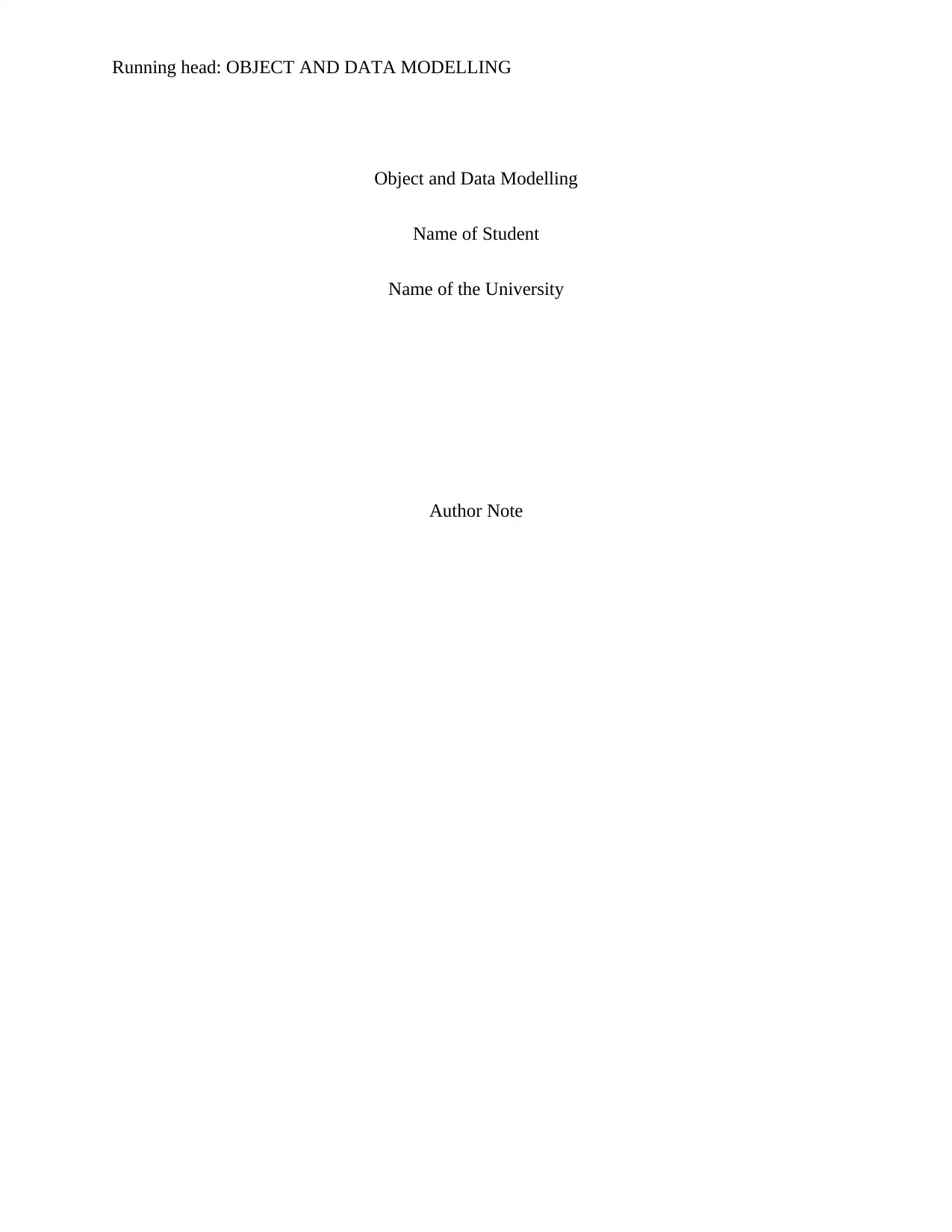
Running head: OBJECT AND DATA MODELLING
Object and Data Modelling
Name of Student
Name of the University
Author Note
Object and Data Modelling
Name of Student
Name of the University
Author Note
Paraphrase This Document
Need a fresh take? Get an instant paraphrase of this document with our AI Paraphraser
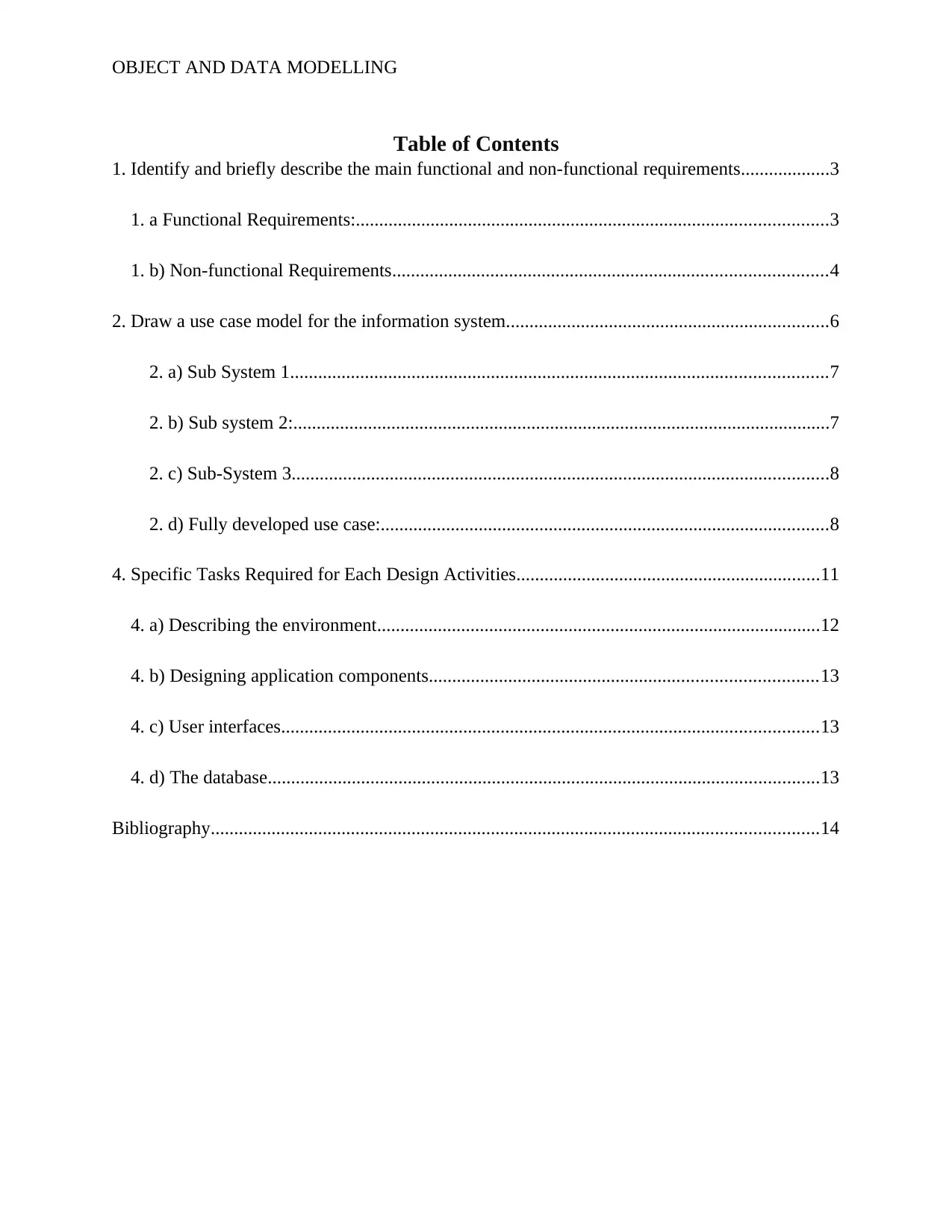
OBJECT AND DATA MODELLING
Table of Contents
1. Identify and briefly describe the main functional and non-functional requirements...................3
1. a Functional Requirements:.....................................................................................................3
1. b) Non-functional Requirements.............................................................................................4
2. Draw a use case model for the information system.....................................................................6
2. a) Sub System 1...................................................................................................................7
2. b) Sub system 2:...................................................................................................................7
2. c) Sub-System 3...................................................................................................................8
2. d) Fully developed use case:................................................................................................8
4. Specific Tasks Required for Each Design Activities.................................................................11
4. a) Describing the environment...............................................................................................12
4. b) Designing application components...................................................................................13
4. c) User interfaces...................................................................................................................13
4. d) The database......................................................................................................................13
Bibliography..................................................................................................................................14
Table of Contents
1. Identify and briefly describe the main functional and non-functional requirements...................3
1. a Functional Requirements:.....................................................................................................3
1. b) Non-functional Requirements.............................................................................................4
2. Draw a use case model for the information system.....................................................................6
2. a) Sub System 1...................................................................................................................7
2. b) Sub system 2:...................................................................................................................7
2. c) Sub-System 3...................................................................................................................8
2. d) Fully developed use case:................................................................................................8
4. Specific Tasks Required for Each Design Activities.................................................................11
4. a) Describing the environment...............................................................................................12
4. b) Designing application components...................................................................................13
4. c) User interfaces...................................................................................................................13
4. d) The database......................................................................................................................13
Bibliography..................................................................................................................................14
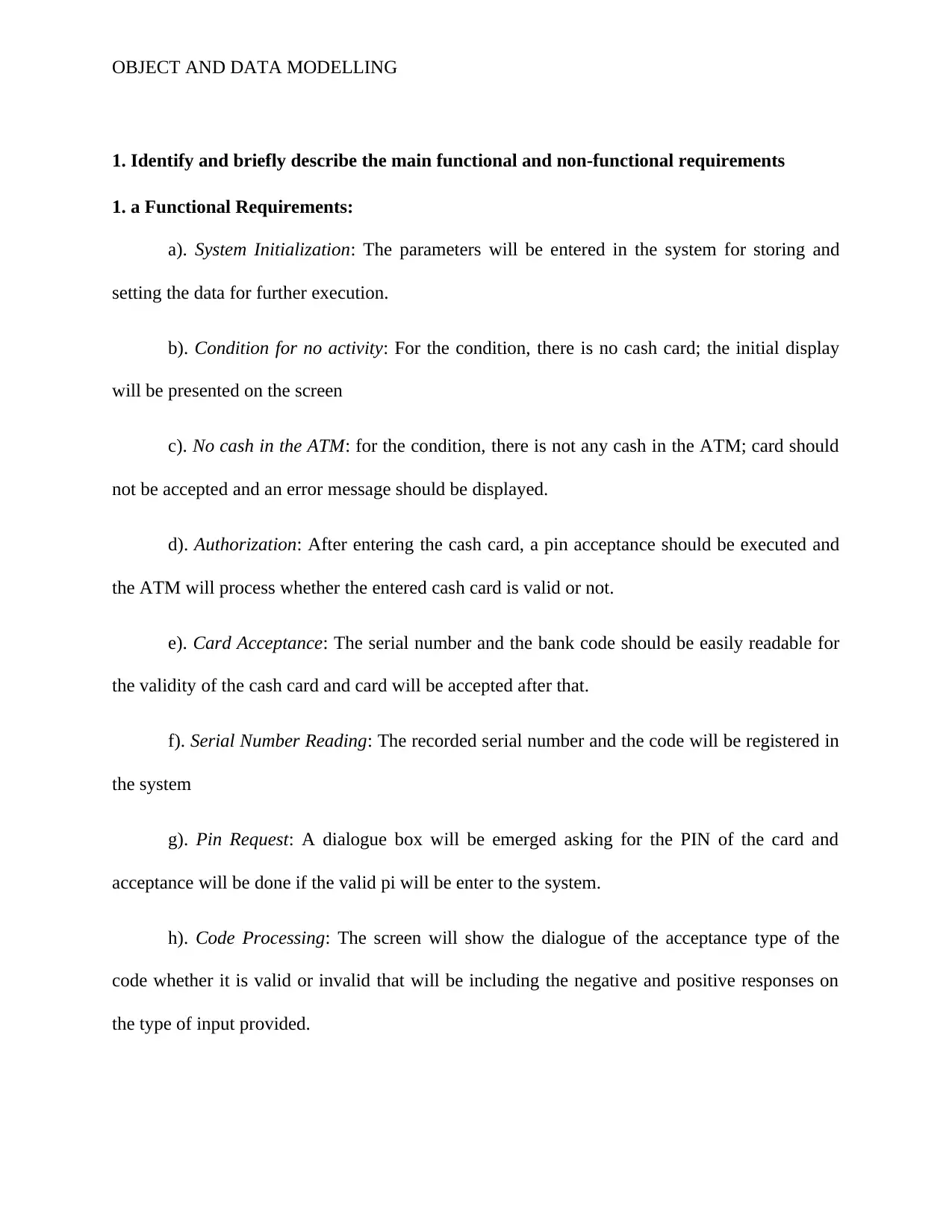
OBJECT AND DATA MODELLING
1. Identify and briefly describe the main functional and non-functional requirements
1. a Functional Requirements:
a). System Initialization: The parameters will be entered in the system for storing and
setting the data for further execution.
b). Condition for no activity: For the condition, there is no cash card; the initial display
will be presented on the screen
c). No cash in the ATM: for the condition, there is not any cash in the ATM; card should
not be accepted and an error message should be displayed.
d). Authorization: After entering the cash card, a pin acceptance should be executed and
the ATM will process whether the entered cash card is valid or not.
e). Card Acceptance: The serial number and the bank code should be easily readable for
the validity of the cash card and card will be accepted after that.
f). Serial Number Reading: The recorded serial number and the code will be registered in
the system
g). Pin Request: A dialogue box will be emerged asking for the PIN of the card and
acceptance will be done if the valid pi will be enter to the system.
h). Code Processing: The screen will show the dialogue of the acceptance type of the
code whether it is valid or invalid that will be including the negative and positive responses on
the type of input provided.
1. Identify and briefly describe the main functional and non-functional requirements
1. a Functional Requirements:
a). System Initialization: The parameters will be entered in the system for storing and
setting the data for further execution.
b). Condition for no activity: For the condition, there is no cash card; the initial display
will be presented on the screen
c). No cash in the ATM: for the condition, there is not any cash in the ATM; card should
not be accepted and an error message should be displayed.
d). Authorization: After entering the cash card, a pin acceptance should be executed and
the ATM will process whether the entered cash card is valid or not.
e). Card Acceptance: The serial number and the bank code should be easily readable for
the validity of the cash card and card will be accepted after that.
f). Serial Number Reading: The recorded serial number and the code will be registered in
the system
g). Pin Request: A dialogue box will be emerged asking for the PIN of the card and
acceptance will be done if the valid pi will be enter to the system.
h). Code Processing: The screen will show the dialogue of the acceptance type of the
code whether it is valid or invalid that will be including the negative and positive responses on
the type of input provided.
⊘ This is a preview!⊘
Do you want full access?
Subscribe today to unlock all pages.

Trusted by 1+ million students worldwide
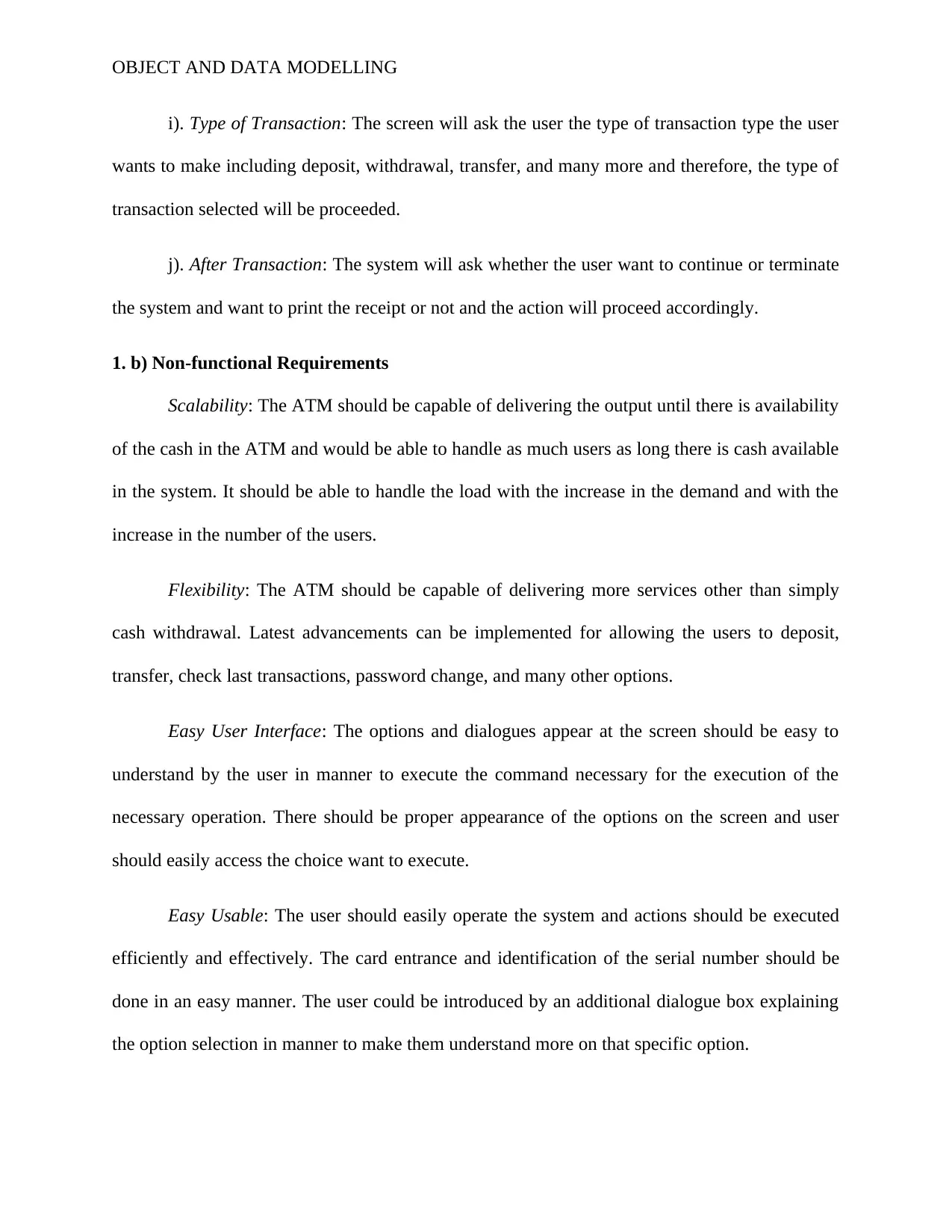
OBJECT AND DATA MODELLING
i). Type of Transaction: The screen will ask the user the type of transaction type the user
wants to make including deposit, withdrawal, transfer, and many more and therefore, the type of
transaction selected will be proceeded.
j). After Transaction: The system will ask whether the user want to continue or terminate
the system and want to print the receipt or not and the action will proceed accordingly.
1. b) Non-functional Requirements
Scalability: The ATM should be capable of delivering the output until there is availability
of the cash in the ATM and would be able to handle as much users as long there is cash available
in the system. It should be able to handle the load with the increase in the demand and with the
increase in the number of the users.
Flexibility: The ATM should be capable of delivering more services other than simply
cash withdrawal. Latest advancements can be implemented for allowing the users to deposit,
transfer, check last transactions, password change, and many other options.
Easy User Interface: The options and dialogues appear at the screen should be easy to
understand by the user in manner to execute the command necessary for the execution of the
necessary operation. There should be proper appearance of the options on the screen and user
should easily access the choice want to execute.
Easy Usable: The user should easily operate the system and actions should be executed
efficiently and effectively. The card entrance and identification of the serial number should be
done in an easy manner. The user could be introduced by an additional dialogue box explaining
the option selection in manner to make them understand more on that specific option.
i). Type of Transaction: The screen will ask the user the type of transaction type the user
wants to make including deposit, withdrawal, transfer, and many more and therefore, the type of
transaction selected will be proceeded.
j). After Transaction: The system will ask whether the user want to continue or terminate
the system and want to print the receipt or not and the action will proceed accordingly.
1. b) Non-functional Requirements
Scalability: The ATM should be capable of delivering the output until there is availability
of the cash in the ATM and would be able to handle as much users as long there is cash available
in the system. It should be able to handle the load with the increase in the demand and with the
increase in the number of the users.
Flexibility: The ATM should be capable of delivering more services other than simply
cash withdrawal. Latest advancements can be implemented for allowing the users to deposit,
transfer, check last transactions, password change, and many other options.
Easy User Interface: The options and dialogues appear at the screen should be easy to
understand by the user in manner to execute the command necessary for the execution of the
necessary operation. There should be proper appearance of the options on the screen and user
should easily access the choice want to execute.
Easy Usable: The user should easily operate the system and actions should be executed
efficiently and effectively. The card entrance and identification of the serial number should be
done in an easy manner. The user could be introduced by an additional dialogue box explaining
the option selection in manner to make them understand more on that specific option.
Paraphrase This Document
Need a fresh take? Get an instant paraphrase of this document with our AI Paraphraser
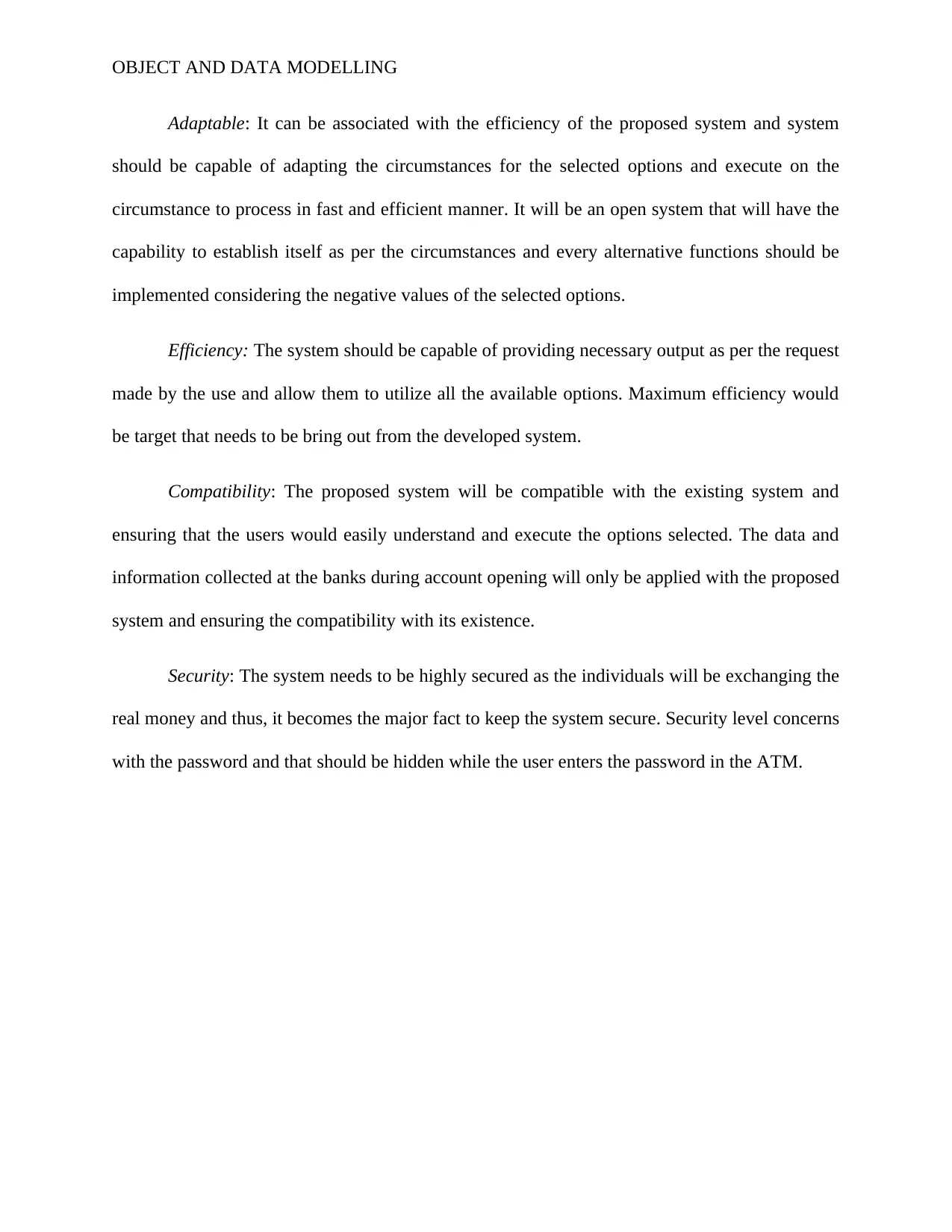
OBJECT AND DATA MODELLING
Adaptable: It can be associated with the efficiency of the proposed system and system
should be capable of adapting the circumstances for the selected options and execute on the
circumstance to process in fast and efficient manner. It will be an open system that will have the
capability to establish itself as per the circumstances and every alternative functions should be
implemented considering the negative values of the selected options.
Efficiency: The system should be capable of providing necessary output as per the request
made by the use and allow them to utilize all the available options. Maximum efficiency would
be target that needs to be bring out from the developed system.
Compatibility: The proposed system will be compatible with the existing system and
ensuring that the users would easily understand and execute the options selected. The data and
information collected at the banks during account opening will only be applied with the proposed
system and ensuring the compatibility with its existence.
Security: The system needs to be highly secured as the individuals will be exchanging the
real money and thus, it becomes the major fact to keep the system secure. Security level concerns
with the password and that should be hidden while the user enters the password in the ATM.
Adaptable: It can be associated with the efficiency of the proposed system and system
should be capable of adapting the circumstances for the selected options and execute on the
circumstance to process in fast and efficient manner. It will be an open system that will have the
capability to establish itself as per the circumstances and every alternative functions should be
implemented considering the negative values of the selected options.
Efficiency: The system should be capable of providing necessary output as per the request
made by the use and allow them to utilize all the available options. Maximum efficiency would
be target that needs to be bring out from the developed system.
Compatibility: The proposed system will be compatible with the existing system and
ensuring that the users would easily understand and execute the options selected. The data and
information collected at the banks during account opening will only be applied with the proposed
system and ensuring the compatibility with its existence.
Security: The system needs to be highly secured as the individuals will be exchanging the
real money and thus, it becomes the major fact to keep the system secure. Security level concerns
with the password and that should be hidden while the user enters the password in the ATM.
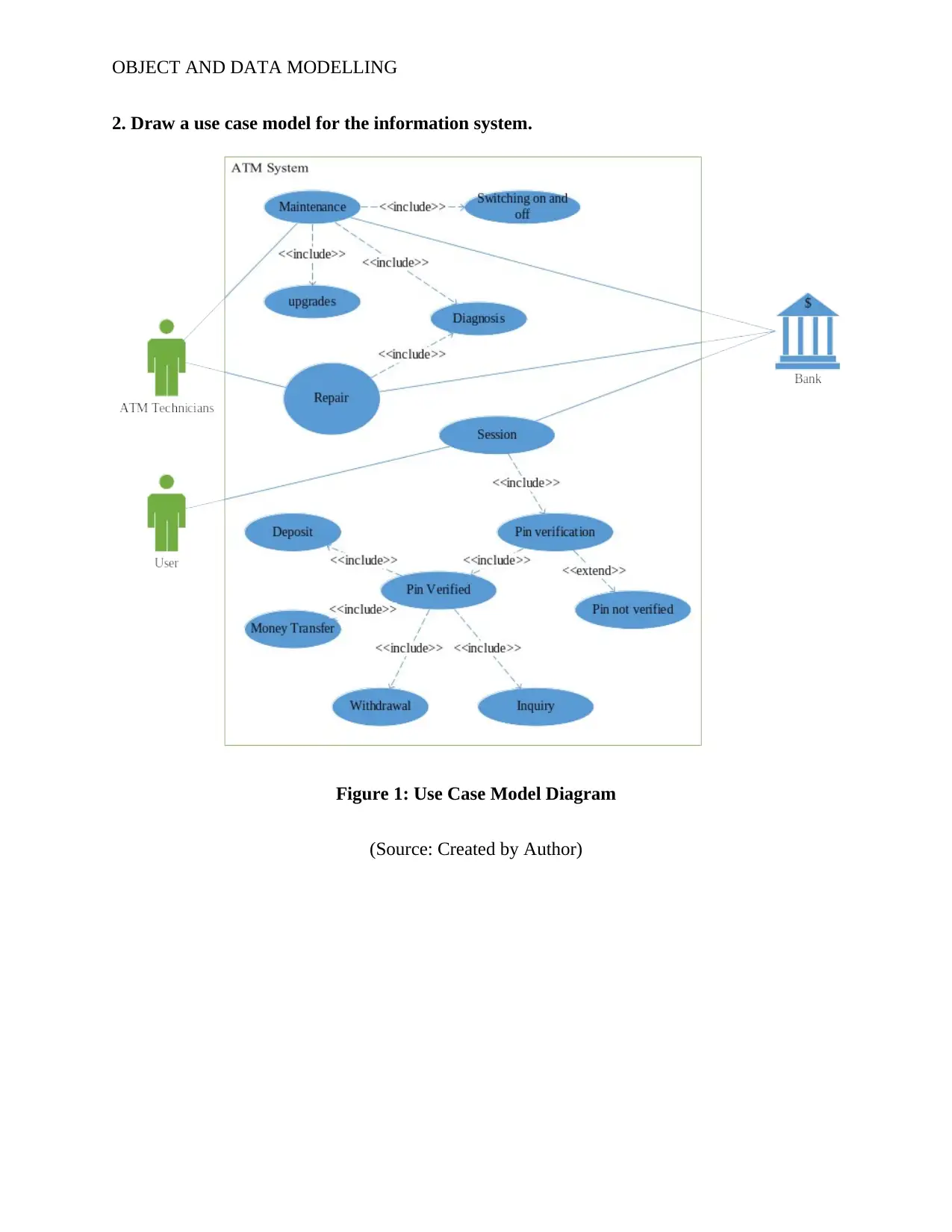
OBJECT AND DATA MODELLING
2. Draw a use case model for the information system.
Figure 1: Use Case Model Diagram
(Source: Created by Author)
2. Draw a use case model for the information system.
Figure 1: Use Case Model Diagram
(Source: Created by Author)
⊘ This is a preview!⊘
Do you want full access?
Subscribe today to unlock all pages.

Trusted by 1+ million students worldwide
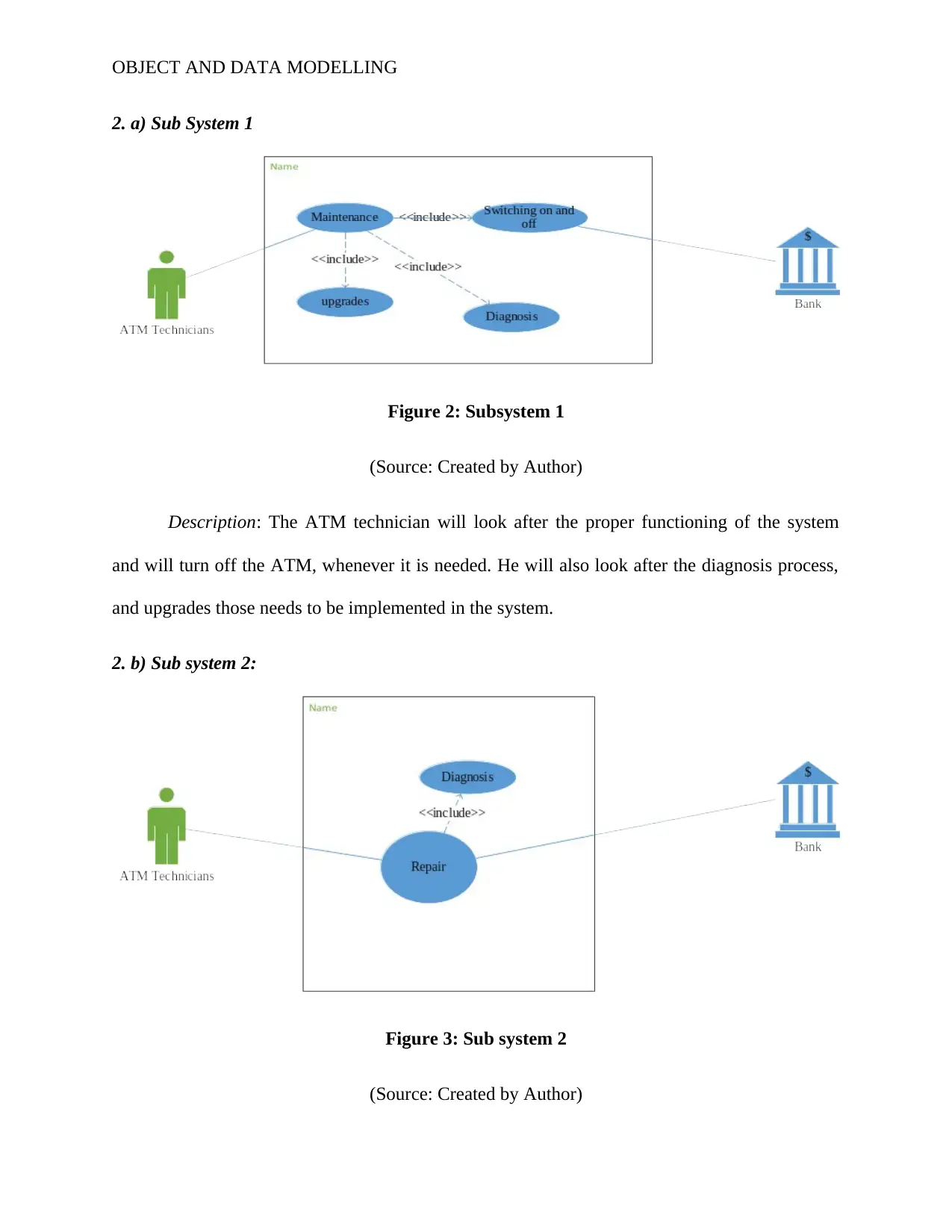
OBJECT AND DATA MODELLING
2. a) Sub System 1
Figure 2: Subsystem 1
(Source: Created by Author)
Description: The ATM technician will look after the proper functioning of the system
and will turn off the ATM, whenever it is needed. He will also look after the diagnosis process,
and upgrades those needs to be implemented in the system.
2. b) Sub system 2:
Figure 3: Sub system 2
(Source: Created by Author)
2. a) Sub System 1
Figure 2: Subsystem 1
(Source: Created by Author)
Description: The ATM technician will look after the proper functioning of the system
and will turn off the ATM, whenever it is needed. He will also look after the diagnosis process,
and upgrades those needs to be implemented in the system.
2. b) Sub system 2:
Figure 3: Sub system 2
(Source: Created by Author)
Paraphrase This Document
Need a fresh take? Get an instant paraphrase of this document with our AI Paraphraser
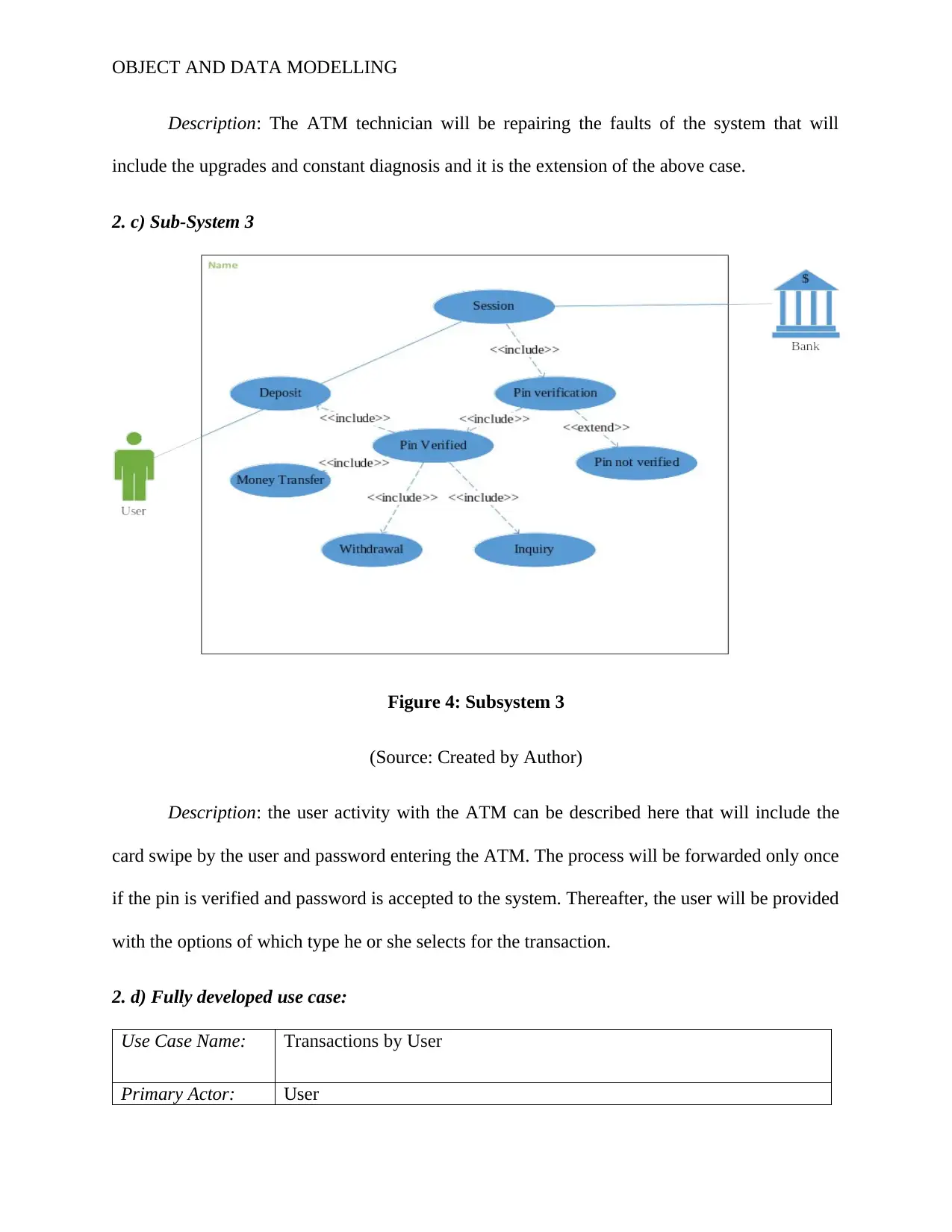
OBJECT AND DATA MODELLING
Description: The ATM technician will be repairing the faults of the system that will
include the upgrades and constant diagnosis and it is the extension of the above case.
2. c) Sub-System 3
Figure 4: Subsystem 3
(Source: Created by Author)
Description: the user activity with the ATM can be described here that will include the
card swipe by the user and password entering the ATM. The process will be forwarded only once
if the pin is verified and password is accepted to the system. Thereafter, the user will be provided
with the options of which type he or she selects for the transaction.
2. d) Fully developed use case:
Use Case Name: Transactions by User
Primary Actor: User
Description: The ATM technician will be repairing the faults of the system that will
include the upgrades and constant diagnosis and it is the extension of the above case.
2. c) Sub-System 3
Figure 4: Subsystem 3
(Source: Created by Author)
Description: the user activity with the ATM can be described here that will include the
card swipe by the user and password entering the ATM. The process will be forwarded only once
if the pin is verified and password is accepted to the system. Thereafter, the user will be provided
with the options of which type he or she selects for the transaction.
2. d) Fully developed use case:
Use Case Name: Transactions by User
Primary Actor: User
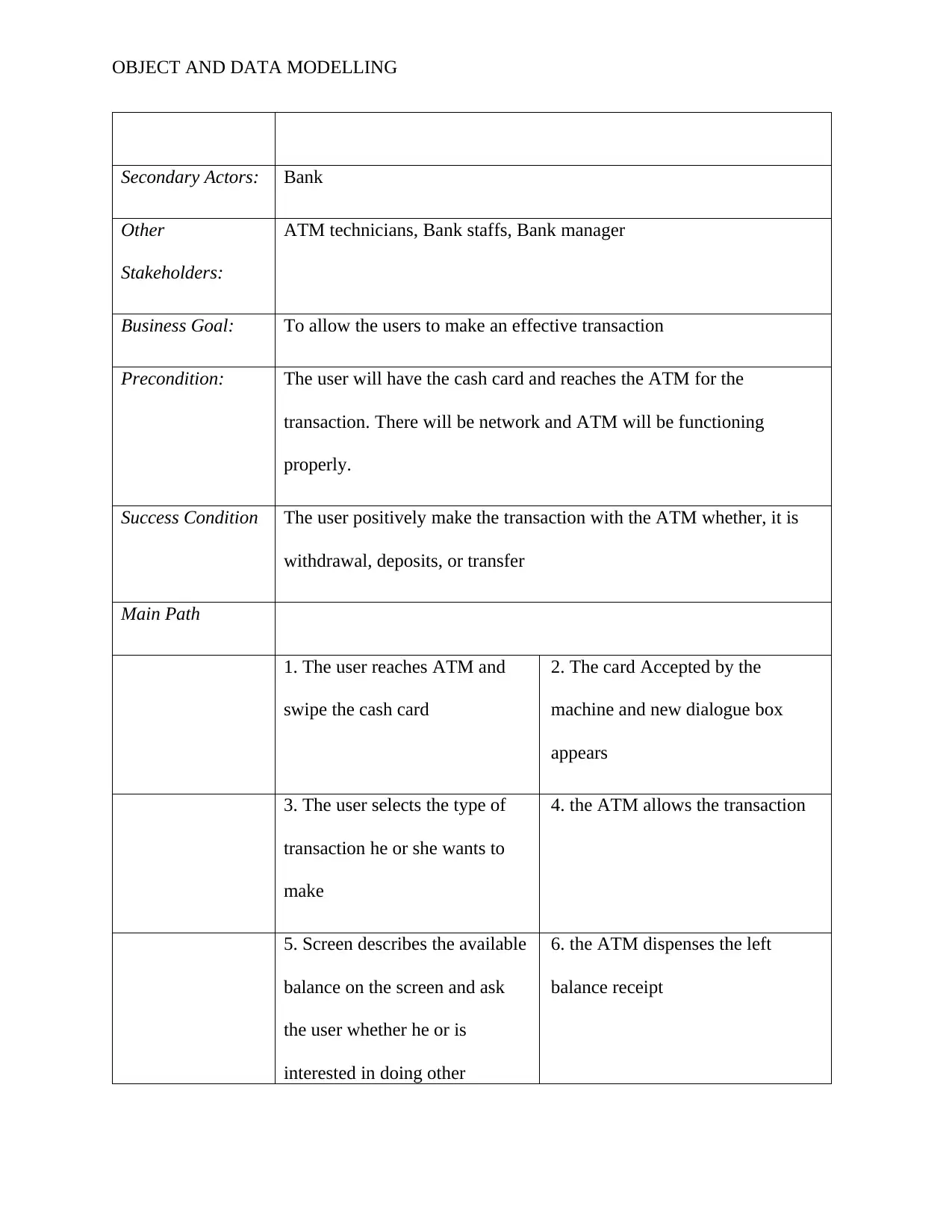
OBJECT AND DATA MODELLING
Secondary Actors: Bank
Other
Stakeholders:
ATM technicians, Bank staffs, Bank manager
Business Goal: To allow the users to make an effective transaction
Precondition: The user will have the cash card and reaches the ATM for the
transaction. There will be network and ATM will be functioning
properly.
Success Condition The user positively make the transaction with the ATM whether, it is
withdrawal, deposits, or transfer
Main Path
1. The user reaches ATM and
swipe the cash card
2. The card Accepted by the
machine and new dialogue box
appears
3. The user selects the type of
transaction he or she wants to
make
4. the ATM allows the transaction
5. Screen describes the available
balance on the screen and ask
the user whether he or is
interested in doing other
6. the ATM dispenses the left
balance receipt
Secondary Actors: Bank
Other
Stakeholders:
ATM technicians, Bank staffs, Bank manager
Business Goal: To allow the users to make an effective transaction
Precondition: The user will have the cash card and reaches the ATM for the
transaction. There will be network and ATM will be functioning
properly.
Success Condition The user positively make the transaction with the ATM whether, it is
withdrawal, deposits, or transfer
Main Path
1. The user reaches ATM and
swipe the cash card
2. The card Accepted by the
machine and new dialogue box
appears
3. The user selects the type of
transaction he or she wants to
make
4. the ATM allows the transaction
5. Screen describes the available
balance on the screen and ask
the user whether he or is
interested in doing other
6. the ATM dispenses the left
balance receipt
⊘ This is a preview!⊘
Do you want full access?
Subscribe today to unlock all pages.

Trusted by 1+ million students worldwide
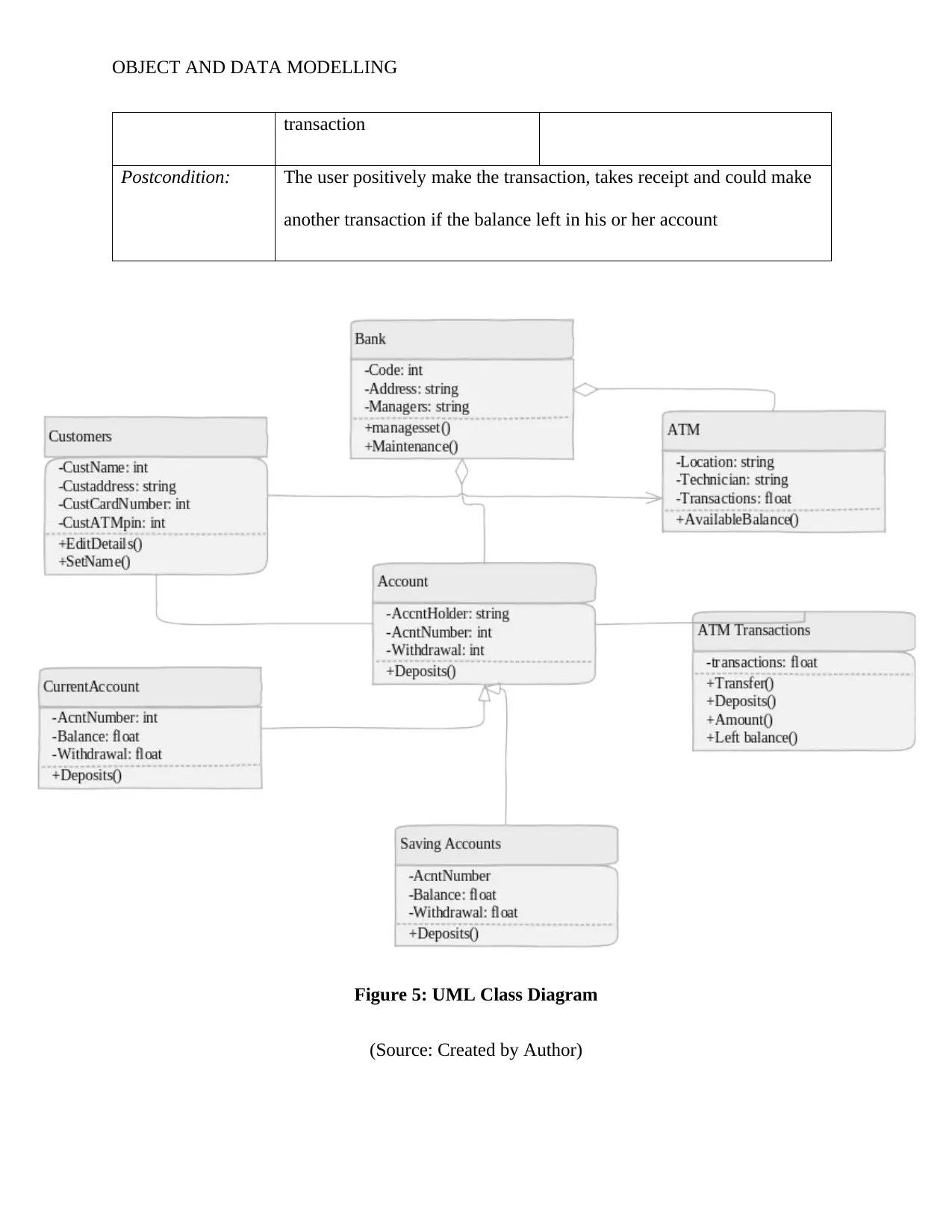
OBJECT AND DATA MODELLING
transaction
Postcondition: The user positively make the transaction, takes receipt and could make
another transaction if the balance left in his or her account
Figure 5: UML Class Diagram
(Source: Created by Author)
transaction
Postcondition: The user positively make the transaction, takes receipt and could make
another transaction if the balance left in his or her account
Figure 5: UML Class Diagram
(Source: Created by Author)
Paraphrase This Document
Need a fresh take? Get an instant paraphrase of this document with our AI Paraphraser
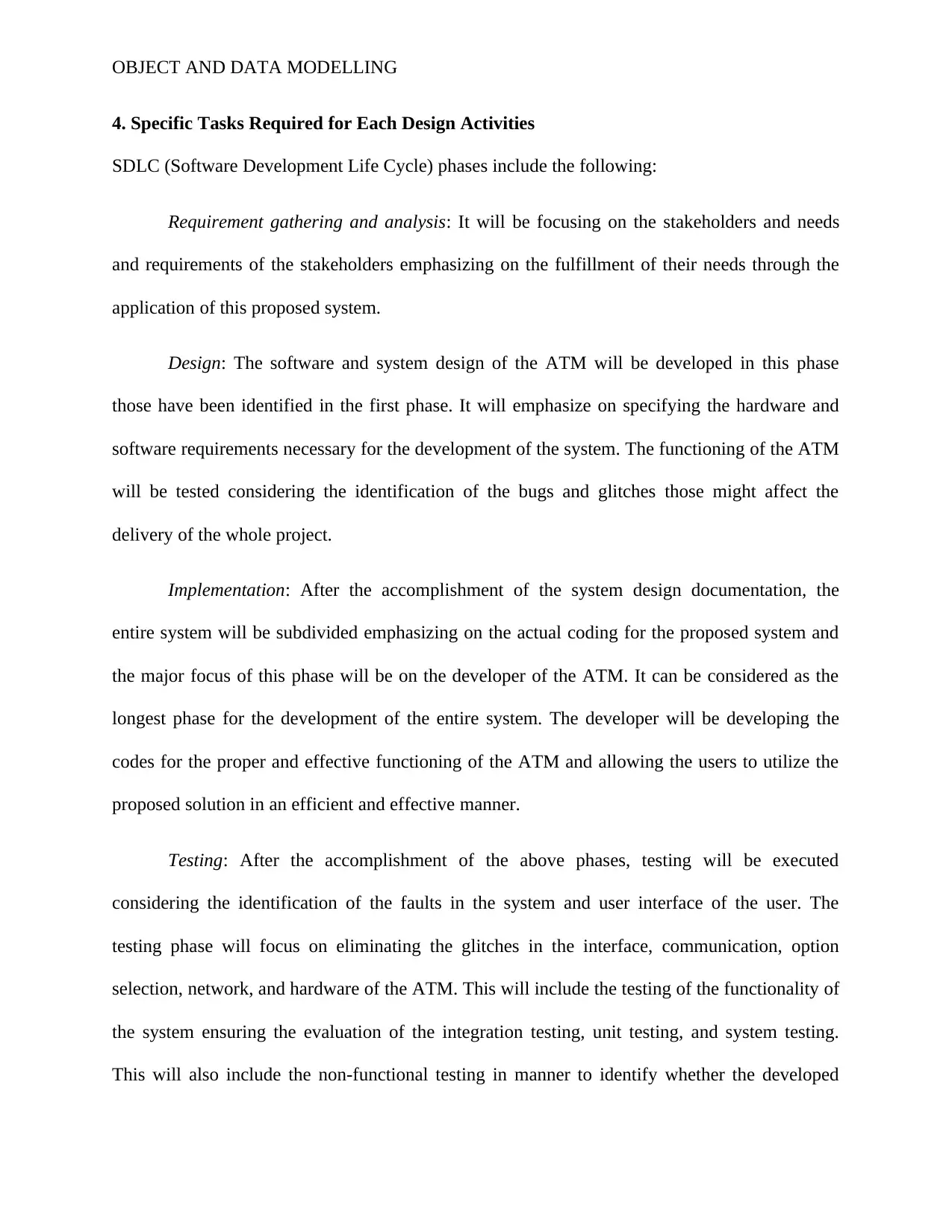
OBJECT AND DATA MODELLING
4. Specific Tasks Required for Each Design Activities
SDLC (Software Development Life Cycle) phases include the following:
Requirement gathering and analysis: It will be focusing on the stakeholders and needs
and requirements of the stakeholders emphasizing on the fulfillment of their needs through the
application of this proposed system.
Design: The software and system design of the ATM will be developed in this phase
those have been identified in the first phase. It will emphasize on specifying the hardware and
software requirements necessary for the development of the system. The functioning of the ATM
will be tested considering the identification of the bugs and glitches those might affect the
delivery of the whole project.
Implementation: After the accomplishment of the system design documentation, the
entire system will be subdivided emphasizing on the actual coding for the proposed system and
the major focus of this phase will be on the developer of the ATM. It can be considered as the
longest phase for the development of the entire system. The developer will be developing the
codes for the proper and effective functioning of the ATM and allowing the users to utilize the
proposed solution in an efficient and effective manner.
Testing: After the accomplishment of the above phases, testing will be executed
considering the identification of the faults in the system and user interface of the user. The
testing phase will focus on eliminating the glitches in the interface, communication, option
selection, network, and hardware of the ATM. This will include the testing of the functionality of
the system ensuring the evaluation of the integration testing, unit testing, and system testing.
This will also include the non-functional testing in manner to identify whether the developed
4. Specific Tasks Required for Each Design Activities
SDLC (Software Development Life Cycle) phases include the following:
Requirement gathering and analysis: It will be focusing on the stakeholders and needs
and requirements of the stakeholders emphasizing on the fulfillment of their needs through the
application of this proposed system.
Design: The software and system design of the ATM will be developed in this phase
those have been identified in the first phase. It will emphasize on specifying the hardware and
software requirements necessary for the development of the system. The functioning of the ATM
will be tested considering the identification of the bugs and glitches those might affect the
delivery of the whole project.
Implementation: After the accomplishment of the system design documentation, the
entire system will be subdivided emphasizing on the actual coding for the proposed system and
the major focus of this phase will be on the developer of the ATM. It can be considered as the
longest phase for the development of the entire system. The developer will be developing the
codes for the proper and effective functioning of the ATM and allowing the users to utilize the
proposed solution in an efficient and effective manner.
Testing: After the accomplishment of the above phases, testing will be executed
considering the identification of the faults in the system and user interface of the user. The
testing phase will focus on eliminating the glitches in the interface, communication, option
selection, network, and hardware of the ATM. This will include the testing of the functionality of
the system ensuring the evaluation of the integration testing, unit testing, and system testing.
This will also include the non-functional testing in manner to identify whether the developed
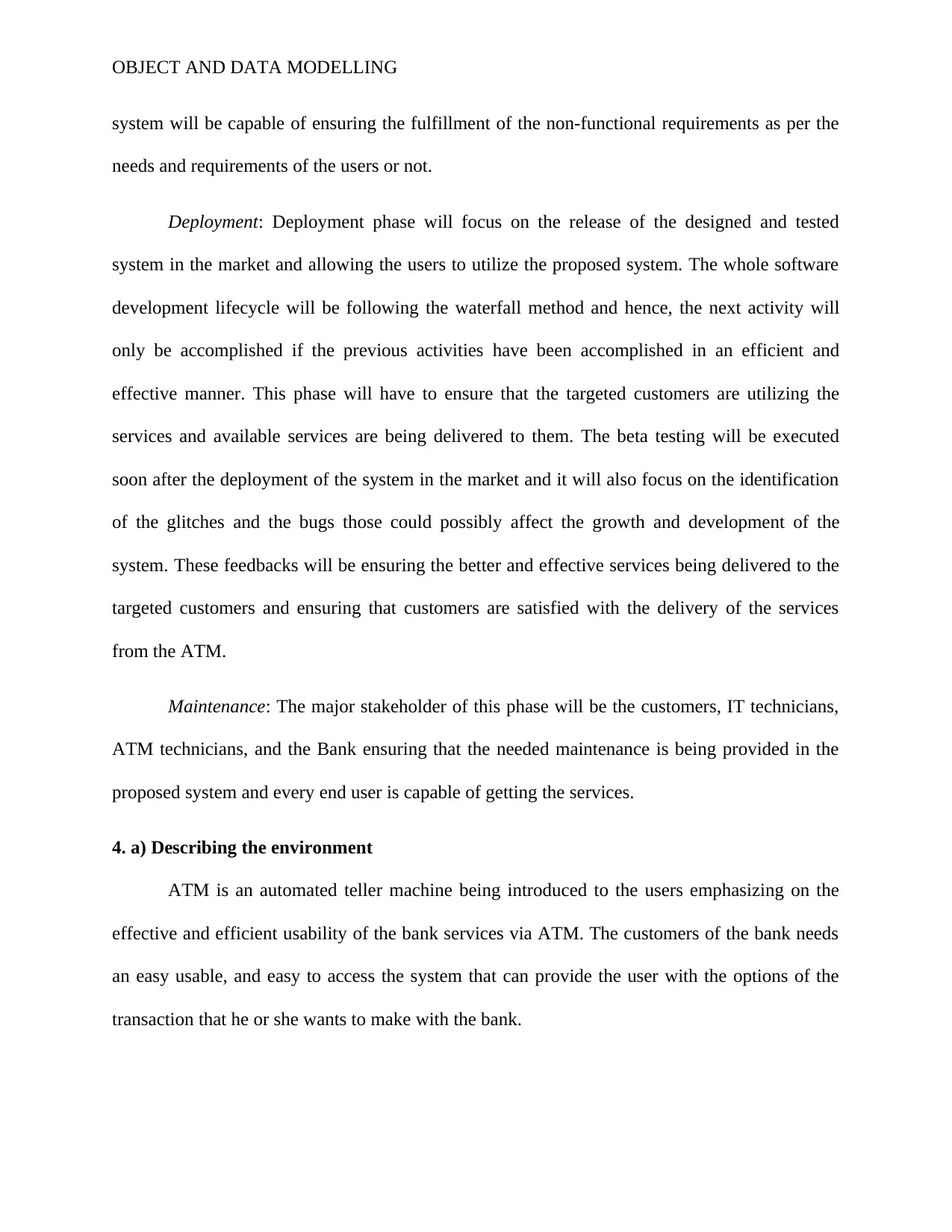
OBJECT AND DATA MODELLING
system will be capable of ensuring the fulfillment of the non-functional requirements as per the
needs and requirements of the users or not.
Deployment: Deployment phase will focus on the release of the designed and tested
system in the market and allowing the users to utilize the proposed system. The whole software
development lifecycle will be following the waterfall method and hence, the next activity will
only be accomplished if the previous activities have been accomplished in an efficient and
effective manner. This phase will have to ensure that the targeted customers are utilizing the
services and available services are being delivered to them. The beta testing will be executed
soon after the deployment of the system in the market and it will also focus on the identification
of the glitches and the bugs those could possibly affect the growth and development of the
system. These feedbacks will be ensuring the better and effective services being delivered to the
targeted customers and ensuring that customers are satisfied with the delivery of the services
from the ATM.
Maintenance: The major stakeholder of this phase will be the customers, IT technicians,
ATM technicians, and the Bank ensuring that the needed maintenance is being provided in the
proposed system and every end user is capable of getting the services.
4. a) Describing the environment
ATM is an automated teller machine being introduced to the users emphasizing on the
effective and efficient usability of the bank services via ATM. The customers of the bank needs
an easy usable, and easy to access the system that can provide the user with the options of the
transaction that he or she wants to make with the bank.
system will be capable of ensuring the fulfillment of the non-functional requirements as per the
needs and requirements of the users or not.
Deployment: Deployment phase will focus on the release of the designed and tested
system in the market and allowing the users to utilize the proposed system. The whole software
development lifecycle will be following the waterfall method and hence, the next activity will
only be accomplished if the previous activities have been accomplished in an efficient and
effective manner. This phase will have to ensure that the targeted customers are utilizing the
services and available services are being delivered to them. The beta testing will be executed
soon after the deployment of the system in the market and it will also focus on the identification
of the glitches and the bugs those could possibly affect the growth and development of the
system. These feedbacks will be ensuring the better and effective services being delivered to the
targeted customers and ensuring that customers are satisfied with the delivery of the services
from the ATM.
Maintenance: The major stakeholder of this phase will be the customers, IT technicians,
ATM technicians, and the Bank ensuring that the needed maintenance is being provided in the
proposed system and every end user is capable of getting the services.
4. a) Describing the environment
ATM is an automated teller machine being introduced to the users emphasizing on the
effective and efficient usability of the bank services via ATM. The customers of the bank needs
an easy usable, and easy to access the system that can provide the user with the options of the
transaction that he or she wants to make with the bank.
⊘ This is a preview!⊘
Do you want full access?
Subscribe today to unlock all pages.

Trusted by 1+ million students worldwide
1 out of 15
Related Documents
Your All-in-One AI-Powered Toolkit for Academic Success.
+13062052269
info@desklib.com
Available 24*7 on WhatsApp / Email
![[object Object]](/_next/static/media/star-bottom.7253800d.svg)
Unlock your academic potential
Copyright © 2020–2025 A2Z Services. All Rights Reserved. Developed and managed by ZUCOL.




